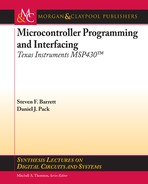0%
99Chapters
0-1Hours read
0kTotal Words
Book Description
This book provides a thorough introduction to the Texas Instruments MSP430 microcontroller. The MSP430 is a 16-bit reduced instruction set (RISC) processor that features ultra low power consumption and integrated digital and analog hardware. Variants of the MSP430 microcontroller have been in production since 1993. This provides for a host of MSP430 products including evaluation boards, compilers, and documentation. A thorough introduction to the MSP430 line of microcontrollers, programming techniques, and interface concepts are provided along with considerable tutorial information with many illustrated examples. Each chapter provides laboratory exercises to apply what has been presented in the chapter. The book is intended for an upper level undergraduate course in microcontrollers or mechatronics but may also be used as a reference for capstone design projects. Also, practicing engineers already familiar with another microcontroller, who require a quick tutorial on the microcontroller, will find this book very useful.Table of Contents
- Preface
- Timer Systems
- Introduction
- Motivation: Real-Time Location Systems (RTLS)
- Approach
- Background
- Time related signal parameters
- MSP430 Clock System (1/2)
- MSP430 Clock System (2/2)
- MSP430 Unified Clock System
- Watchdog Timer
- Basic Timer 1
- Input Capture and Output Compare Features
- Laboratory Exercise: Generation of Varying Pulse Width Modulated Signals to Control DC Motors
- Summary
- References and Further Reading
- Chapter Problems
- Resets and Interrupts
- Analog Peripherals
- Communication Systems
- System Level Design
- Programming
- Authors' Biographies
- Index
